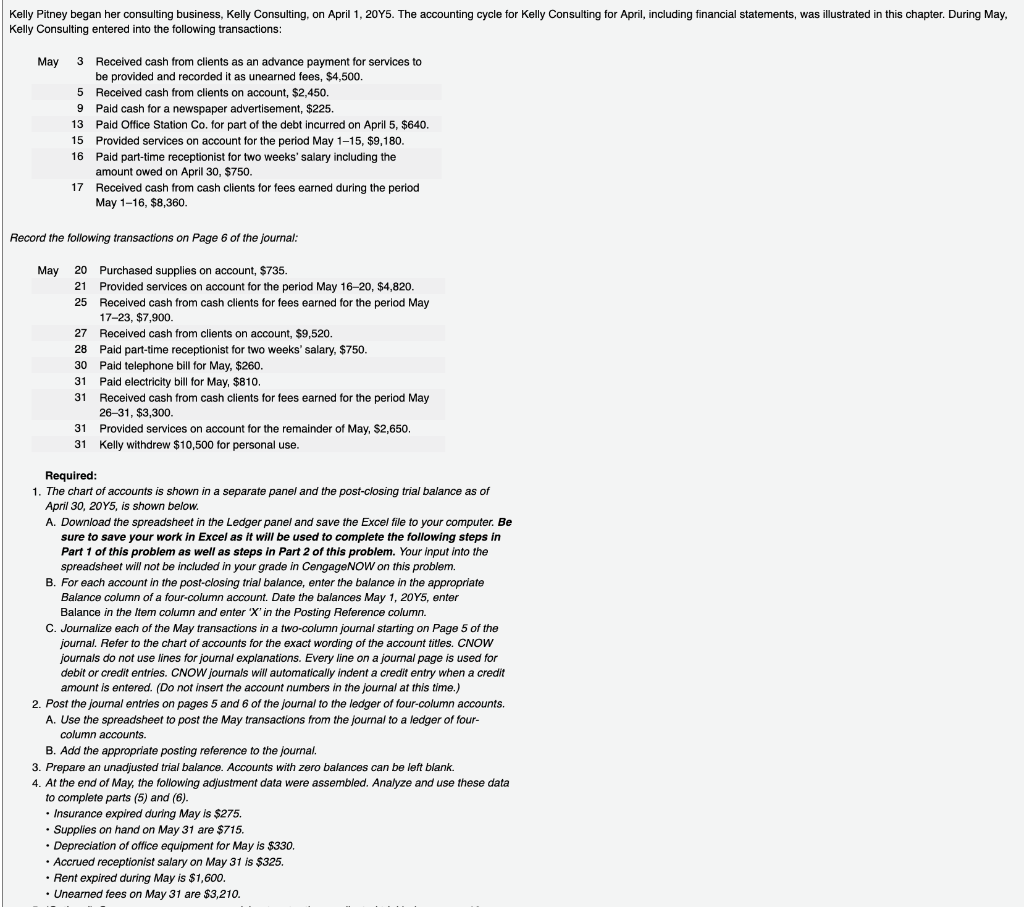

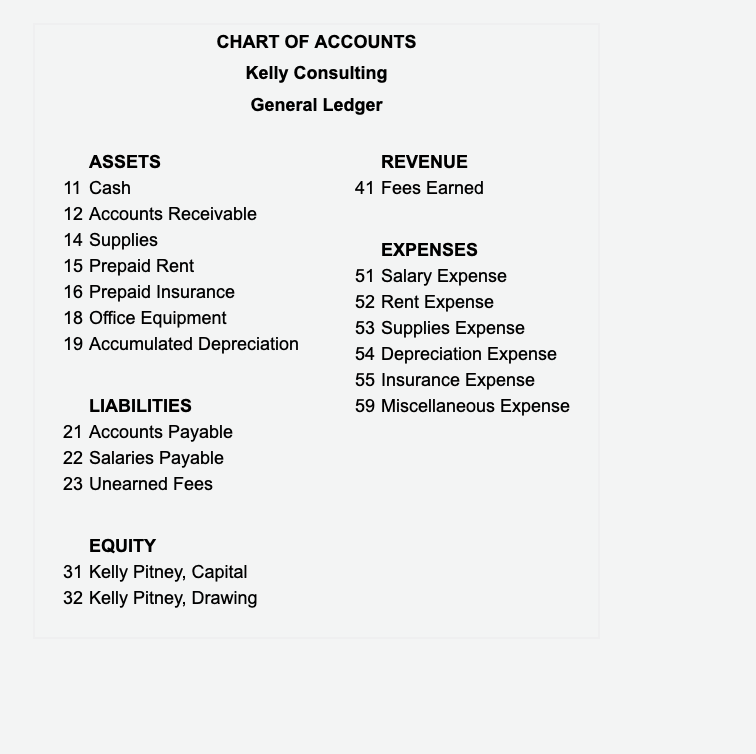
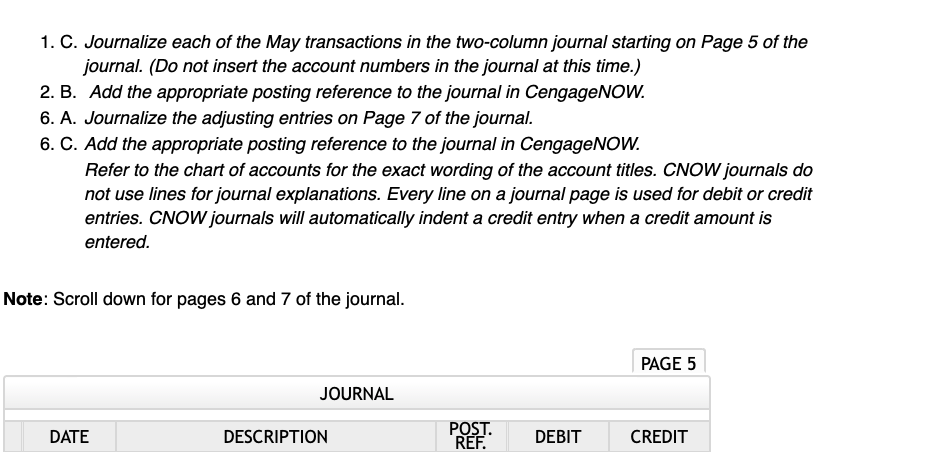


The above is part one. Please complete all of part one with the right titles so I know which is which. Below is part two.

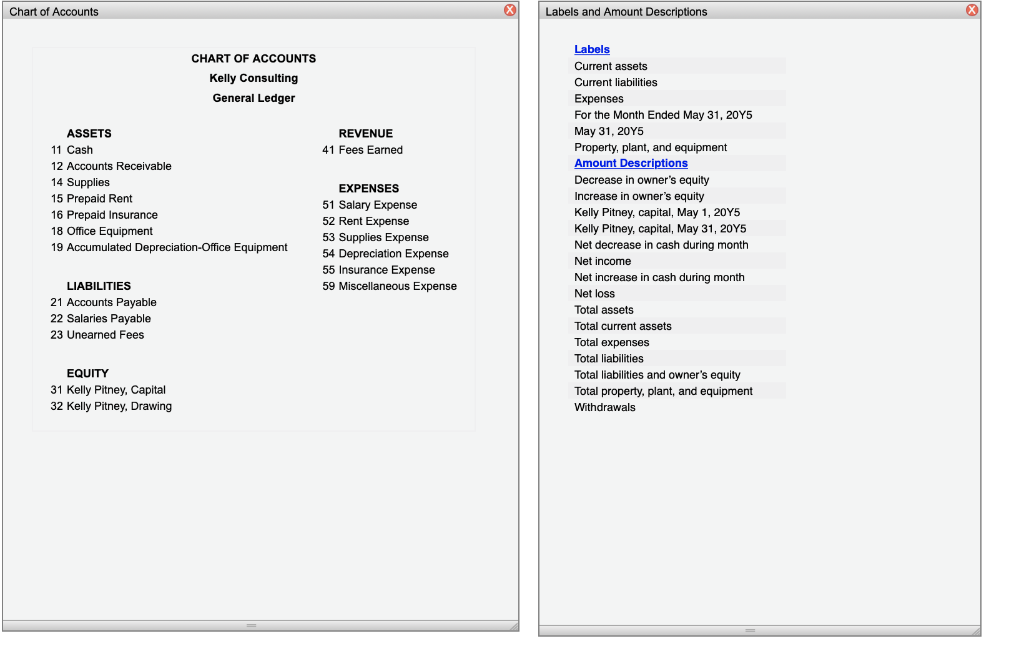
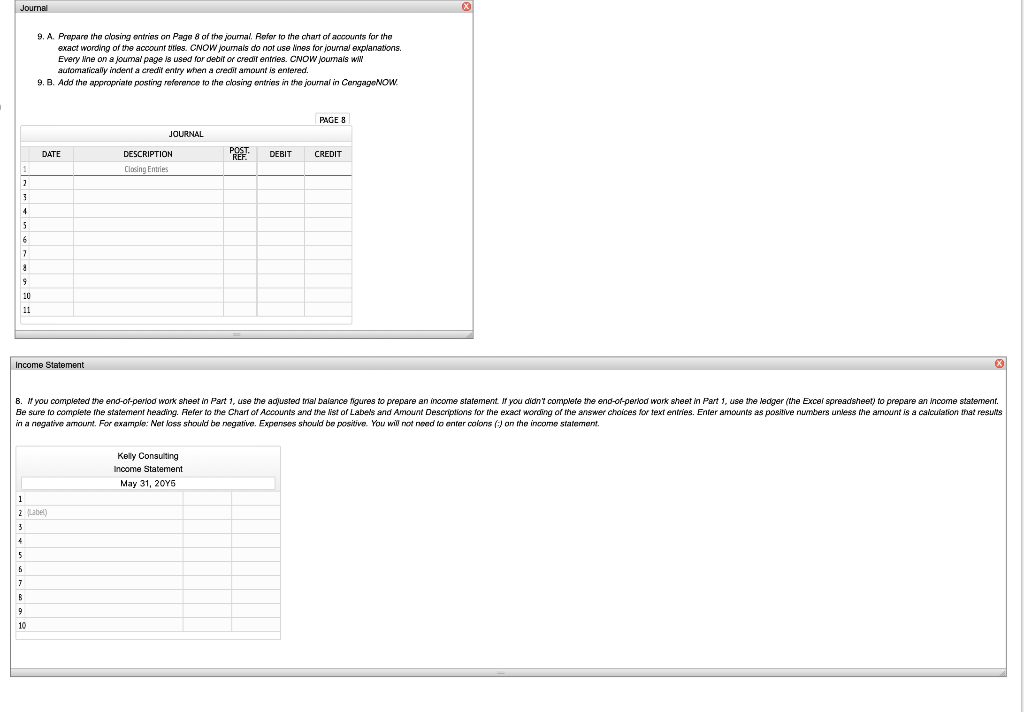
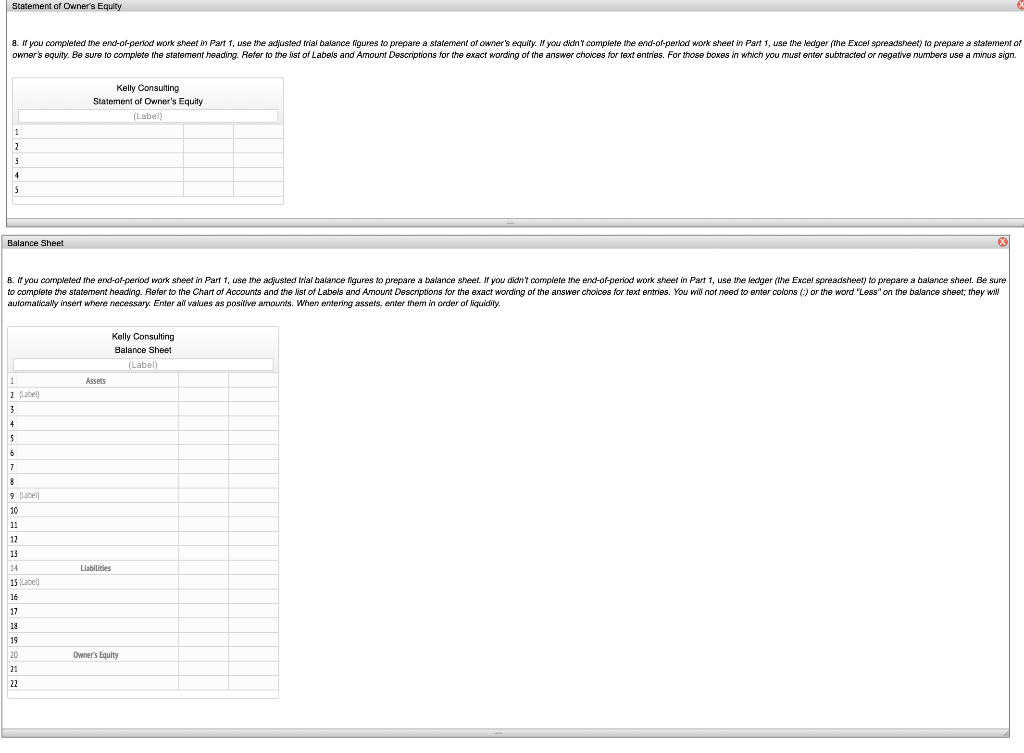

Kelly Pitney began her consulting business, Kelly Consulting, on April 1, 20Y5. The accounting cycle for Kelly Consulting for April, including financial statements, was illustrated in this chapter. During May, Kelly Consulting entered into the following transactions: May 3 Received cash from clients as an advance payment for services to be provided and recorded it as unearned fees, $4,500. 5 Received cash from clients on account, $2,450 9 Paid cash for a newspaper advertisement, $225. 13 Paid Office Station Co. for part of the debt incurred on April 5, $640. 15 Provided services on account for the period May 1-15, $9,180. loved ser 16 Paid part-time receptionist for two weeks' salary including the amount owed on April 30, $750. 17 Received cash from cash clients for fees earned during the period May 1-16, $8,360. Record the following transactions on Page 6 of the journal: May 20 Purchased supplies on account, $735. 21 Provided services on account for the period May 16-20, $4,820. 25 Received cash from cash clients for fees earned for the period May 17-23, $7,900. 27 Received cash from clients on account, $9,520. 28 Pald part-time receptionist for two weeks' salary, $750. an 30 Paid telephone bill for May, $260. an elephone 31 Paid electricity bill for May, $810. 31 Received cash from cash clients for fees earned for the period May 26-31, $3,300. 31 Provided services on account for the remainder of May, $2,650. 31 Kelly withdrew $10,500 for personal use. Required: 1. The chart of accounts is shown in a separate panel and the post-closing trial balance as of April 30, 2045, is shown below. A. Download the spreadsheet in the Ledger panel and save the Excel file to your computer. Be sure to save your work in Excel as it will be used to complete the following steps in Part 1 of this problem as well as steps in Part 2 of this problem. Your input into the spreadsheet will not be included in your grade in CengageNOW on this problem. B. For each account in the post-closing trial balance, enter the balance in the appropriate Balance column of a four-column account. Date the balances May 1, 2045, enter Balance in the Item column and enter 'X' in the Posting Reference column. C. Journalize each of the May transactions in a two-column journal starting on Page 5 of the journal. Refer to the chart of accounts for the exact wording of the account titles. CNOW journals do not use lines for journal explanations. Every line on a journal page is used for debit or credit entries. CNOW journals will automatically indent a credit entry when a credit amount is entered. (Do not insert the account numbers in the journal at this time.) 2. Post the journal entries on pages 5 and 6 of the journal to the ledger of four-column accounts. A. Use the spreadsheet to post the May transactions from the journal to a ledger of four- column accounts. the appropriate posting reference to the journal. 3. Prepare an unadjusted trial balance. Accounts with zero balances can be left blank. Mathe 4. At the end of May, the following adjustment data were assembled. Analyze and use these data to complete parts (5) and (6). Insurance expired during May is $275. Supplies on hand on May 31 are $715. Depreciation of office equipment for May is $330. Accrued receptionist salary on May 31 is $325. Rent expired during May is $1,600. - Unearned fees on May 31 are $3,210. B. Add the approach 5. (Optional) On your own paper or spreadsheet, enter the unadjusted trial balance on a 10- column end-of-period spreadsheet (work sheet), and complete the spreadsheet. Find a blank end-of-period work sheet in the Excel spreadsheet you previously downloaded. 6. A. Journalize the adjusting entries on Page 7 of the journal. Refer to the chart of accounts for the exact wording of the account titles. CNOW journals do not use lines for journal explanations. Every line on a journal page is used for debit or credit entries. CNOW journals will automatically indent a credit entry when a credit amount is entered. B. Post the adjusting entries to the ledger, inserting balances in the accounts affected. C. Add the appropriate posting reference to the adjusting entries in the journal in CengageNOW. 7. Prepare an adjusted trial balance. Accounts with zero balances can be left blank. CREDIT Kelly Consulting POST-CLOSING TRIAL BALANCE April 30, 2015 ACCOUNT TITLE DEBIT Cash 22,100.00 Accounts Receivable 3,400.00 Supplies 1,350.00 Prepaid Rent 3,200.00 Prepaid Insurance 1,500.00 Office Equipment 14,500.00 Accumulated Depreciation Accounts Payable Salaries Payable Unearned Fees 1 Kelly Pitney, Capital 2 Totals 46,050.00 330.00 800.00 120.00 2,500.00 42,300.00 46,050.00 CHART OF ACCOUNTS Kelly Consulting General Ledger REVENUE 41 Fees Earned ASSETS 11 Cash 12 Accounts Receivable 14 Supplies 15 Prepaid Rent 16 Prepaid Insurance 18 Office Equipment 19 Accumulated Depreciation EXPENSES 51 Salary Expense 52 Rent Expense 53 Supplies Expense 54 Depreciation Expense 55 Insurance Expense 59 Miscellaneous Expense LIABILITIES 21 Accounts Payable 22 Salaries Payable 23 Unearned Fees EQUITY 31 Kelly Pitney, Capital 32 Kelly Pitney, Drawing 1. C. Journalize each of the May transactions in the two-column journal starting on Page 5 of the journal. (Do not insert the account numbers in the journal at this time.) 2. B. Add the appropriate posting reference to the journal in CengageNOW. 6. A. Journalize the adjusting entries on Page 7 of the journal. 6. C. Add the appropriate posting reference to the journal in CengageNOW. Refer to the chart of accounts for the exact wording of the account titles. CNOW journals do not use lines for journal explanations. Every line on a journal page is used for debit or credit entries. CNOW journals will automatically indent a credit entry when a credit amount is entered. Note: Scroll down for pages 6 and 7 of the journal. PAGE 5 JOURNAL DATE DESCRIPTION POST. REF. DEBIT CREDIT 3. Prepare an unadjusted trial balance. Accounts with zero balances can be left blank. Kelly Consulting UNADJUSTED TRIAL BALANCE May 31, 2045 ACCOUNT TITLE DEBIT CREDIT 7. Prepare an adjusted trial balance. Accounts with zero balances can be left blank. Kelly Consulting ADJUSTED TRIAL BALANCE May 31, 2045 Kelly Pitney began her consulting business, Kelly Consulting, on April 1, 20Y5. The accounting cycle for Kelly Consulting for April, including financial statements, was illustrated in this chapter. During May, Kelly Consulting entered into transactions. In Part 1 of this problem, the accounting cycle was completed up through the preparation of the adjusted trial balance. Required: 8. If you completed the end-of-period work sheet in Part 1, use the adjusted trial balance figures to prepare an income statement, a statement of owner's equity, and a balance sheet. If you didn't complete the end-of-period work sheet in Part 1, use the ledger (the Excel spreadsheet) to prepare an income statement, a statement of owner's equity, and a balance sheet. Be sure to read the instructions above each statement carefully. 9. A. Prepare the closing entries on Page 8 of the journal. Refer to the chart of accounts for the exact wording of the account titles. CNOW journals do not use lines for journal explanations. Every line on a journal page is used for debit or credit entries. CNOW journals will automatically indent a credit entry when a credit amount is entered. B. Use the spreadsheet to post the closing entries to the ledger of four-column accounts. Add the appropriate posting reference to the journal in CengageNOW. 10. Prepare a post-closing trial balance. Chart of Accounts X Labels and Amount Descriptions X CHART OF ACCOUNTS Kelly Consulting General Ledger REVENUE 41 Fees Earned ASSETS 11 Cash 12 Accounts Receivable 14 Supplies 15 Prepaid Rent 16 Prepaid Insurance 18 Office Equipment 19 Accumulated Depreciation Office Equipment EXPENSES 51 Salary Expense 52 Rent Expense 53 Supplies Expense 54 Depreciation Expense 55 Insurance Expense 59 Miscellaneous Expense Labels Current assets Current liabilities Expenses For the Month Ended May 31, 2045 May 31, 2045 Property, plant, and equipment Am Amount Descriptions Decrease in owner's equity Increase in owner's equity Kelly Pitney, capital, May 1, 2045 Kelly Pitney, capital, May 31, 2045 M Net decrease in cash during month M Net income Net increase in cash during month Net loss *** Total assets Total current assets Total expenses Total liabilities Total liabilities and owner's equity Total property, plant, and equipment Withdrawals LIABILITIES 21 Accounts Payable 22 Salaries Payable 23 Unearned Fees EQUITY 31 Kelly Pitney, Capital 32 Kelly Pitney, Drawing Journal 9. A. Prepare the closing entries on Page 8 of the journal. Refer to the chart of accounts for the exact wording of the account bine. CNOW joumals do not use lines for journal explanations. Every Ine on a joumal page is used for debitor credir entries. CNOW Jumals www automatically indent a credit entry when a crechl amount is entered. 9. B. Add the appropriate posting reference to the closing entries in the journal in CangageNOW. PAGE 8 JOURNAL DATE POST DEBIT CREDIT DESCRIPTION Closing Entries 2 3 4 6 7 a 10 11 Income Statement 8. If you completed the end-of-period work sheet in Part 1, use the adjusted mial balance figures to prepare an income statement if you didn't complete the end-or-perlod work sheet in Part 1, use the leager (the Excel spreadsheet) to prepare an income statement. Be sure to complete the statement heading. Refer to the Chart of Accounts and the list of Labels and Amount Descriptions for the exact wording of the answer choices for text entries. Enter amounts as positive numbers unless the amount is a calculation that results in a negative amount. For example: Ner loss should be negative. Expenses should be positive. You will not need to enter colons () on the income statement Kelly Consulting Income Statement May 31, 2015 1 2 Label 3 4 5 6 7. B 9 10 Statement of Owner's Equity 8. If you completed the end-of-period work sheet in Part 1, use the adjusted trial balance figures to prepare a statement of owner's equity. If you didn't complete the end-of-period work sheet in Part 1, use the ledger (the Excel spreadsheet) to prepare a statement of owner's equity. Be sure to complete the statement heading. Refer to the list of Labels and Amount Descriptions for the exact wording of the answer choices for text entries. For those boxes in which you must enter subtracted or negative numbers use a minus sign. Kelly Consulting Statement of Owner's Equity Labels 1 2 4 5 Balance Sheet B. If you completed the end-of-period work sheet in Part 1, use the adjusted trial balance figures to prepare a balance sheet. If you didn't complete the end-of-period work sheet in Part 1, use the ledger (the Excel spreadsheet) to prepare a balance sheet. Be sure to complete the statement heading. Refer to the Chart of Accounts and the list of Labels and Amount Descriptions for exact wording of the answer choices for text entries. You will not need to enter colons (c) or the word "Less' on the balance sheet; they wil automatically insert where necessary. Enter all values as positive amounts. When entering assets, enter them in order of liquidity. Kelly Consulting Balance Sheet (Label) Assets 1 2 Label) 3 4 5 6 7 & 9 Label 10 11 12 13 14 15 Label 16 Liabilities 17 18 19 Owner's Equity 20 21 22 Post-Closing Trial Balance 10. Prepare a post-closing trial balance. CREDIT Kelly Consulting POST-CLOSING TRIAL BALANCE May 31, 2015 ACCOUNT TITLE DEBIT 1 Cash 2 Accounts Receivable 3 Supplies 4 Prepaid Rent 5 Prepaid Insurance 6 Office Equipment 7 Accumulated Depreciation Office Equipment 8 Accounts Payable 9 Salaries Payable 10 Unearned Fees 11 Kelly Pitney, Capital 12 Totals

















